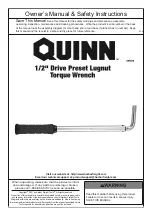
Maintenance
7
1. Secure the manifold by its center portion, in a bench vise, with the valve knobs pointing upward.
2. Using the .061" hex wrench, loosen and remove the knob inserts (4) from the pressure and vent valve
stems.
3. Loosen the 3/4" locknuts (1) on the pressure and vent valve threaded needle housings (10).
4. Using the needle housing socket (65580) and torque wrench, loosen and remove the needle/housing
assembly (10, 1).
5. To disassemble the isolation valve, first remove the valve needle (18) by turning the gear clockwise.
6. Loosen and remove the valve housings (19) using the isolation valve housing removal socket (59793)
female socket (65581) and torque wrench.
7. Remove the valve stem seats (8) and valve needle seats (9) using the needle-nose pliers.
8. Remove the inner and outer O-rings (28, 27) and back-up rings (31, 30) from the valve stem seats and
wash all parts in solvent (de-natured alcohol).
9. To remove valve seats (7) from either the pressure, vent or isolation valves, try blowing compressed air
through the inlet and outlet fittings. Otherwise, the center holes will have to be drilled and a tap used to
extract the seat.
10. Using the electric hand drill with the No. 43 bit, carefully drill out the seat hole, ensuring that the drill
does not touch the hole in the manifold housing directly beneath the seat.
11. Blow out any chips from the seat area using compressed air.
12. While holding the 4-40 tap steady and perpendicular to the seat, slowly turn until the tap starts to engage
the seat.
13. When the tap has engaged into the seat, use a small hammer and gently knock upward against the tap
handle to extract the seat.
14. After the seat has been removed, blow any remaining chips from the seat area.
3.2.6
ORION 2C Manifold, Vernier Control Disassembly
Tools required:
A/R solvent (de-natured alcohol)
1-1/4" wrench
screwdriver (flat-blade)
socket wrench
isolation valve socket (PN 59793)
female socket (PN 65581)
1. With the manifold housing mounted in a vise, turn the vernier shaft (14) clockwise until the piston is
bottomed.
2. Loosen and remove the end cap (13) using a 1-1/4" wrench. At certain points during removal the end cap
will appear to lock up. If this occurs, rotate the shaft clockwise until the end cap is free to turn.
3. Remove the O-ring (29) from the end cap.
4. Remove the self-sealing screw (36) that acts as the piston key.
5. Extract the piston (15) by partially screwing in the threaded end of the shaft and pulling.
6. Remove the O-ring (32) from the piston groove.
7. To disassemble the end cap/shaft assembly, mount the end cap in the vise.
8. Loosen and remove the locknut (20) using the isolation valve housing socket (PN 59793), female socket
(65581), and socket wrench.
9. Loosen and remove the end bushing (12) using the same socket. Remove the shaft (14). Remove the
mylar bearing washers (41 or 42) from both sides of the shaft flange.
10. Use a small pick or screwdriver to remove the O-ring (27) from the inner groove of the end cap (13).
11. Wash all parts in solvent and blow dry with compressed air.









































